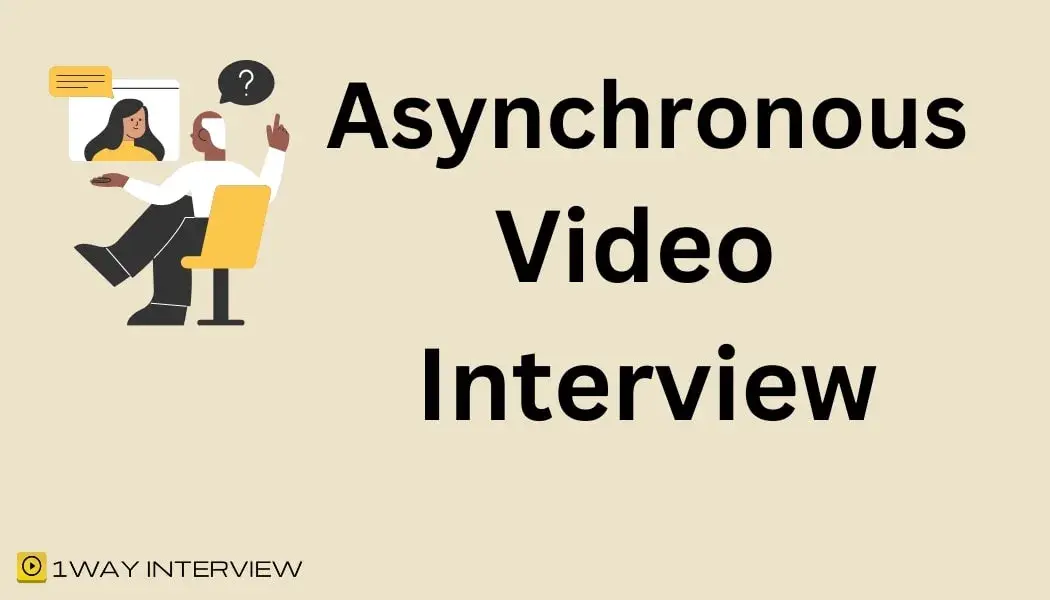Asynchronous video interviews are a customer-friendly, time-efficient trend in the recruitment process.They are a good replacement for classic interview methods, which are now widely used by recruiters worldwide. Asynchronous interviews make it easier for employers to be more flexible with the availability of candidates, minimize time wasted during the interview, and expand markets looking for candidates worldwide since more organizations move to online platforms due to remote work. Those who wish to spend less time on the process and devote more effort to assessing the candidates’ aptitudes and qualifications will benefit from this type of format.
Scalable for today’s talent acquisition, as organisations move to remote and hybrid work cultures, traditional synchronous video interviews could not be more relevant. They help hiring teams to engage with a wider range of candidates without the constraints of time zones and availability clashes, enabling inclusive hiring. Asynchronous interviewing helps employers save time in the face of high volumes of applications – it is a valuable opportunity to quickly evaluate a candidate.
What is an Asynchronous Video Interview?

An asynchronous interview means the candidate records their answers to pre-set questions in advance, removing the social interaction component from the process. Employers and candidates find it convenient because they can work in such a way from various work shifts since this modality does not involve waiting for both the interviewer and the candidate. Employers can easily enjoy increased flexibility and efficiency since the pre-recorded video interview responses can be viewed anytime.
How Do Asynchronous Interviews Work?
The procedure is simple and usually consists of the following steps:
- Setting Up Asynchronous Video Interview Questions: Employers decide or shortlist appropriate interview questions that can elicit answers addressing soft and technical skills and organizational culture. An video interview platform then receives these queries.
- Instructions for Candidates: Once candidates have been invited to the interview, very detailed instructions are provided on how to log in to answer the async interview questions. They can also receive platform instructions if it is their first time to participate in an asynchronous interview.
- Recording Responses: Conventionally, many candidates opt to complete the interview either in one meeting or stretch it out to several sittings and respond to the questions according to a set timetable.
- Checking Responses: After the end of the test, the candidate’s qualifications are checked by the answers recorded from the candidate’s video or voice. This allows hiring managers to see the difference between the responses from different candidates and also their body language and communication skills.
Unlike face-to-face interviews where time is a limiting factor, the full asynchronous video interview process enables the recruiters to learn as much as they can about the candidates based on their answers.

How to Conduct an Async Interview?
The following crucial actions will help you conduct a successful async interview:
- Establish Your Objectives: Use questions that will allow the candidates to show what kind of abilities or traits you value.
- Carefully prepare your questions: Develop open-ended items that are unambiguous, and the desired response requires a high level of deliberation. Among the asynchronous video interview questions could be something like “How would you tackle a time-sensitive issue?” or “What was a conflict you faced in a project that was completed for a client?”
- Examine the platform: Ensure that the platform you have chosen, for example, is working well and offers the best experience to the prospects.
- Give precise instructions: Give candidates precise instructions on how to prepare, including the desired response time, what to wear, and any other requirements.
- Create a Review Procedure: Scheduling should be done for assessing the videos while observing to the right standards of assessments.
Benefits of AVI for Employers
- Prevents scheduling conflict and saves time for physical activities as well as for operational schedules. The most obvious benefit of using asynchronous video interviews is the time that the companies and the candidates both can save. Employers, including the recruitment department, can evaluate candidates faster without initially scheduling face-to-face meetings, especially for a remote or high-traffic screening test.
- Enables the achievement of an objective and standardized evaluation. In order to achieve an objective and systematic procedure for assessment, the hiring teams may also match the candidates’ responses side by side in live and recorded as well as on-demand modes of asynchronous interviews.
- Provides candidates with a low-stress environment. Unlike synchronous forms, the offer to give answers in an unscheduled manner in a relaxed atmosphere may minimize interview stress and maximize confidence.
- Grows international talent acquisition. The asynchronous video interview model means that employers can access candidates globally without social barriers.
Best Practices for Asynchronous Video Interviews
Take into account these practices to get the most out of asynchronous video interviews:
- Asking Careful Questions about Design: To structure enquiries that will raise the profile of a candidate’s problem-solving skills, interpersonal compatibility with co-workers, and his or her knowledge and proficiency in the technical aspects of the job. For instance, questions like “Tell me about a time that you were proactive in a project” will lead the applicant in the direction of declaring independent decision-making skills. The following are some of the most typical asynchronous interview example questions: “Tell me about yourself,” because as much as it is fitting to be an ice-breaking statement, it often forms the basis of the first question an interviewer is likely to ask.
- Ensure Uniformity Criteria for Evaluation: To avoid distortions and unfairness when grading completed assessments, responses should be graded based on a standard or universally acceptable format of analyzing the work and skills of candidates.
- Express Your Expectations Evidently: This is to ensure that both parties should be assured and have primordial information such as the procedure and schedule of the candidates.

Asynchronous Video Interview Platforms
Async video interviews are supported by many platforms, which include features that facilitate both candidates and recruiters:
- 1Way Interview: is perfect solution to enhance one-way video interviewing timeliness for businesses since it also include configurable question sets, simple user interfaces, as well as integration features.
- Spark Hire: system has features for response management and the customization of the interview questions.
- Willo: platform has versatile tools for asynchronous recruiting, but if you are looking for more, check out alternative to Willo.
- HireVue: all-encompassing product that embeds video interviews and online recruiting tools for analyzing data with the help of artificial intelligence.
- Vidcruiter: site offers several forms of online assessments, including skills assessments and recorded video interviews. However, there is site like Vidcruiter with more affordable options.
Asynchronous Video Interview in the Future of Hiring
Asynchronous video interviews will be used even more in the hiring process as technology grows, especially in fully distributed or partially distributed organizations. It might be even covered deeper in the future with applicants’ answers available fully to hiring teams, along with such things as personality traits or tone analysis.
It may one day replace the conventional screening interviews for specific screening tests as organizations move toward remote and digital hiring procedures. This would afford yet another practical and easily scalable means to evaluate professors of professions that hold value.
Conclusion
In conjunction with the new patterns of today’s selection activities, asynchronous video interviews can become a valuable and effective replacement for traditional interview practices. This approach to interviewing has its advantages to both employers and employees, as it helps reduce schedule issues and increase worldwide accessibility, as well as helping the employer impartially view the candidate. Recruiters should not ignore such a comfortable and modern way of communication.
Finally, by using asynchronous interviews, companies get the benefits since they get to make better hiring decisions based on facts. This approach helps reduce time to hire and offers great candidate experience and making it a perfect fit for environments with high turnover rates.
Asynchronous interviews are a great strategy that talent acquisition teams in organizations and HR departments should embrace when aiming to shorten the recruiting process.